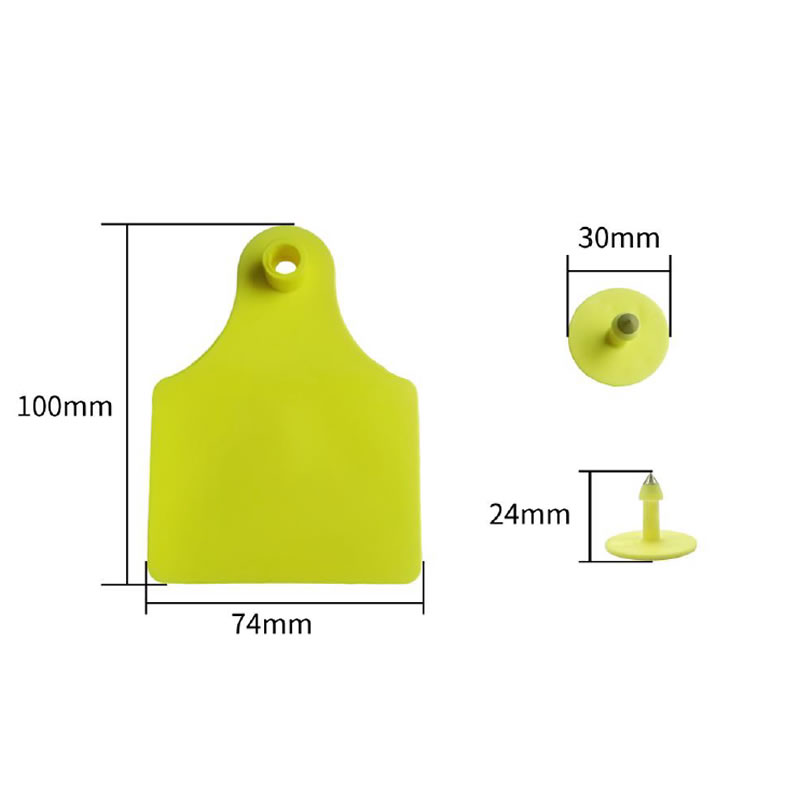- 16
- Jun
RFID Ear Tag, Ultrahigh Frequency Ear Tag, UHF Ear Tag
RFID Ear Tag: Revolutionizing Identification and Tracking
Introduction: RFID ear tags, also known as ultrahigh frequency (UHF) ear tags, have emerged as a groundbreaking technology in the field of livestock management. These small electronic devices, equipped with radio frequency identification (RFID) technology, offer numerous advantages in animal identification and tracking. In this article, we will explore the benefits, necessity, applications, and precautions associated with RFID ear tags.
Advantages of RFID Ear Tags:
- Enhanced Efficiency: RFID ear tags provide a swift and accurate method of identifying and tracking animals. With the ability to read multiple tags simultaneously, the process of identifying and managing large herds becomes significantly faster and more efficient. This reduces labor costs and saves valuable time for farmers and livestock managers.
- Improved Traceability: By utilizing RFID technology, the entire lifecycle of an animal can be traced seamlessly. From birth to slaughter or reproduction, RFID ear tags enable comprehensive monitoring, ensuring food safety, and facilitating disease control. The ability to track an animal’s movements and history enables prompt action in the event of a disease outbreak or product recall.
- Increased Data Accuracy: UHF ear tags allow for precise and reliable data collection. The unique identification number embedded in each tag ensures accurate recording of individual animal information, such as breed, birth date, vaccination history, and medical treatments. This data can be crucial for maintaining accurate records, making informed breeding decisions, and optimizing herd management strategies.
Necessity of RFID Ear Tags:
- Regulatory Compliance: Many countries and regulatory bodies require the use of RFID ear tags for livestock identification and traceability. Compliance with these regulations is essential for ensuring the safety and integrity of the food supply chain. RFID ear tags provide an efficient and standardized method for meeting these requirements.
- Disease Control: The outbreak of diseases in livestock can have catastrophic consequences. RFID ear tags play a vital role in disease control and prevention. By quickly identifying and isolating infected animals, the spread of diseases can be mitigated. Additionally, the ability to trace the movement of animals aids in identifying potential sources of contamination and preventing further outbreaks.
Applications of RFID Ear Tags:
- Livestock Management: RFID ear tags find extensive application in the management of various livestock, including cattle, sheep, pigs, and poultry. The tags enable easy identification of individual animals, monitoring of their health and behavior, and tracking of their movements throughout the supply chain.
- Breeding Programs: RFID ear tags facilitate efficient breeding programs by providing accurate data on each animal’s lineage, genetic traits, and reproductive history. This information aids in selective breeding, optimizing breeding outcomes, and improving overall herd genetics.
- Supply Chain Optimization: The implementation of RFID ear tags in livestock enables seamless integration with supply chain management systems. From the farm to the consumer, each animal can be accurately tracked, ensuring transparency, quality control, and product authenticity.
Precautions for RFID Ear Tag Usage:
- Proper Tag Placement: Ensuring correct placement of the RFID ear tag is crucial for readability and animal comfort. Follow manufacturer guidelines to affix the tag securely in the animal’s ear while avoiding potential injury or discomfort.
- Maintenance and Replacement: Periodically check the condition of the RFID ear tags to ensure they are functioning properly. Damaged or malfunctioning tags should be replaced promptly to maintain accurate data collection and animal identification.
- Reader Compatibility: When investing in RFID ear tags, ensure compatibility with the corresponding readers and software systems. This ensures seamless integration and efficient data management.
Conclusion: RFID ear tags, or UHF ear tags, revolutionize the way livestock is identified, tracked, and managed. Their advantages in efficiency, traceability, and data accuracy make them indispensable in modern livestock operations. With their widespread application in livestock management, breeding programs, and supply chain optimization, RFID ear tags have become a necessity for farmers and livestock managers. By adhering to proper usage precautions, farmers can fully leverage the benefits of RFID ear tags to enhance productivity, animal welfare, and overall operational success.
rfid ear tag, ultrahigh frequency ear tag, uhf ear tag, square ultrahigh frequency ear tag, square uhf ear tag, square ultra high frequency ear tag, rfid ear tag, square rfid ear tag, ultrahigh frequency ear tag,square rfid ear tag for cattle, ultrahigh frequency ear tag,ultrahigh frequency ear tag, uhf ear tag, ultra high frequency ear tag, rfid ear tag, rfid ear tag, ultrahigh frequency ear tag for cattle, rfid ear tags for cattle, animal rfid ear tag, square animal rfid ear tag, uhf rfid animal ear tag, ultrahigh frequency ear tag,rfid ear tags for cattle, rfid ear tags for pigs, rfid animal ear tag, uhf ear tag,ultrahigh frequency animal ear tag, rfid ear tag, ultrahigh frequency ear tag, uhf ear tag, how do rfid ear tags work,

